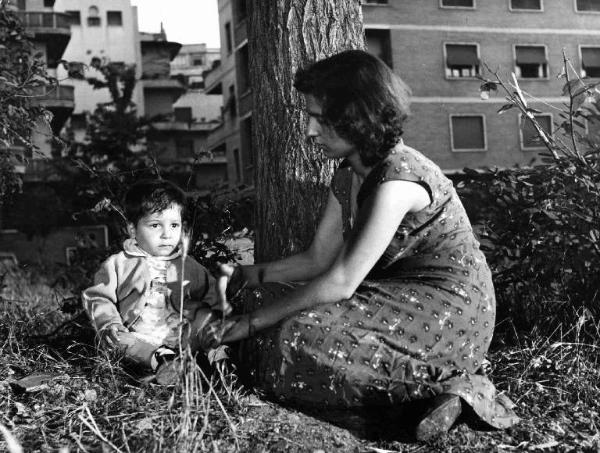L’Amore in Città (1953) is a groundbreaking anthology film that captures the multifaceted nature of love and human connection in post-war Italy. Directed by six of Italian cinema’s most influential filmmakers—Cesare Zavattini, Federico Fellini, Michelangelo Antonioni, Dino Risi, Carlo Lizzani, and Francesco Maselli—the film offers a kaleidoscopic view of romance, heartbreak, and social realities. Each segment is a unique exploration of love’s complexities, framed within the context of a changing Italy.
A Bold Experiment in Neorealism
The project, conceived by Cesare Zavattini, sought to merge the principles of Italian neorealism with an episodic narrative format. The goal was to depict love not through idealized romance but as a raw, often painful aspect of everyday life. This innovative approach emphasized authenticity, using non-professional actors, real locations, and unvarnished storytelling to reflect the struggles and emotions of ordinary people.
Each segment functions as a standalone story, yet collectively, they create a powerful commentary on the human condition, exploring themes of loneliness, desire, betrayal, and societal pressures.
The Episodes: A Tapestry of Love Stories
- “Paid Love” (Cesare Zavattini)
This opening segment investigates the lives of sex workers in Rome, presenting a journalistic, almost documentary-like perspective. By portraying their humanity and struggles, Zavattini challenges societal prejudices and invites empathy for women marginalized by circumstance. - “Attempted Suicide” (Michelangelo Antonioni)
Antonioni’s contribution is a poignant exploration of despair, focusing on women who have attempted suicide because of heartbreak. Their testimonies, presented in a raw and restrained manner, highlight the emotional toll of love gone awry. - “Paradise for Three Hours” (Dino Risi)
Risi’s lighthearted yet bittersweet episode takes place at a Saturday night dance for working-class youth. Amid the clumsy flirtations and fleeting connections, the segment captures the universal longing for love and companionship, even in the most transient forms. - “Marriage Agency” (Carlo Lizzani)
Lizzani examines the business of matchmaking through a story about a man who seeks a wife through a marriage agency. The episode critiques the transactional nature of some relationships, shedding light on the economic and social motivations behind matrimony. - “Story of Caterina” (Francesco Maselli and Cesare Zavattini)
One of the most emotionally powerful segments, this story follows a single mother who, out of desperation, abandons her child. Using non-professional actors and stark realism, the episode reflects the harsh realities faced by impoverished women in post-war Italy. - “The Affairs of a Journalist” (Federico Fellini)
Fellini’s contribution is characteristically whimsical yet incisive. It follows a journalist investigating Roman nightlife in search of stories about love, exposing the superficiality and contradictions of modern relationships.
The Setting: Rome as a Character
Rome serves not merely as a backdrop but as an integral character in L’Amore in Città. Its vibrant streets, crowded dance halls, and quiet alleys encapsulate the contradictions of urban life—where love can bloom but also wither. The city’s juxtaposition of ancient history and modernity reflects the transitional period in Italian society, as traditional values clash with emerging freedoms.
The directors use Rome’s varied locations to emphasize the disparities between social classes. From the bustling energy of working-class neighborhoods to the detached elegance of bourgeois settings, the film highlights how love—and its challenges—manifests differently across societal divides.
Themes: Love, Loneliness, and Social Critique
L’Amore in Città is as much about societal critique as it is about personal relationships. The film examines how economic hardship, gender roles, and social expectations shape the experience of love. By addressing topics like prostitution, suicide, and arranged marriages, the directors confront taboos that were rarely explored in Italian cinema of the time.
Loneliness emerges as a recurring theme, with many characters yearning for connection but finding themselves isolated by circumstance or emotional barriers. This sense of alienation underscores the fragility of human relationships and the vulnerability inherent in love.
Legacy and Influence
While L’Amore in Città was not a commercial success upon its release, it has since gained recognition as a significant work in Italian cinema. The film’s innovative format paved the way for later anthology films and demonstrated the potential of collaboration among great directors. It also expanded the boundaries of neorealism, blending its documentary-style authenticity with more experimental and poetic approaches.
The film remains a poignant snapshot of post-war Italy, capturing the hopes and struggles of a society rebuilding itself. Its unflinching exploration of love’s complexities resonates with contemporary audiences, reminding us that the search for connection and meaning is both timeless and universal.
L’Amore in Città stands as a testament to the power of collaboration and the enduring relevance of love in all its forms. Through its episodic structure and raw storytelling, it offers a deeply human portrait of a society in flux, where the pursuit of love remains both a source of joy and heartache.
Watch the movie on Movieitaly+
Read more articles over here






